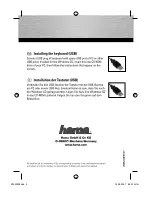
6-2
Program Mode
The Program Mode Page
The Soft Buttons in Program Mode
Use the
Octav–
and
Octav+
soft buttons to transpose up or down by a full octave. Pressing both
Octav
buttons simultaneously returns the transposition to its original setting.
Pressing the
Panic
soft button sends an All Notes Off message and an All Controllers Off
message on all 16 MIDI channels.
Press the
Info
soft button to see all of the controller assignments of the current program. Scroll
down the page using the Alpha Wheel or the
Plus/Minus
buttons.
The
Xpose-/Xpose+
buttons are a shortcut for quick transposition in semitone (half step)
increments. You can use them to transpose the entire PC3A as much as three octaves up or down.
The top line of the display shows the current amount of transposition (Xpose). Pressing both
Xpose
buttons simultaneously returns the transposition to zero. The
Xpose
buttons transpose the
PC3A, as well as any MIDI devices connected to the PC3A’s MIDI Out port. Changing the
transposition with the soft buttons also changes the corresponding setting on the MIDI mode
TRANSMIT page.
The Info Box
The info box at the left of the Program mode page gives you information about the current
program. Generally, the info box shows the keymap assigned to each layer
(for KB3 programs, the
info box shows the keymap used for the upper tone wheels.)
The line beneath the name of the keymap
indicates the keyboard range of that layer. In the diagram above, for example, there’s one layer
that extends from C 0 to C 8—the default range. The representation of these layer ranges is
approximate; they’re intended to let you know if you have a layered keyboard (lines
overlapping) or a split keyboard (lines not overlapping). Stereo keymap layers are indicated in
the info box with a double circle symbol. The info box can display up to four layers at a time. If
the current program has more than four layers, you can view their keymaps by pressing and
holding down the
Enter
button and scrolling with the
Chan/Layer
buttons.
Note:
For VAST layers using KVA oscillators, the info box may or may not show the name of the oscillator
being used. See Advanced Use Of KVA Oscillators
on page 6-55
for more details.
The info box can also be set to show the assignment and current MIDI CC value for the last
moved controller, see
Display
on page 11-3
for details.
Controllers Assignments For Factory ROM Programs
Many of the programs included with the PC3A (factory ROM programs) can be controlled by
using the PC3A’s physical controllers (sliders, wheels, switches, pedals, etc.) Press the Info soft
button to see all of the controller assignments of the current program. Here is a list of controllers
and their commonly assigned program parameters:
•
Slider I
(MIDI 28) - Slider I usually controls the program’s send level to an Aux effect
(usually reverb or delay.) In this case, use slider I to control the reverb or delay level.
•
SW Switch
- The SW switch often enables a layer (like strings for piano program) or an effect.
•
Mod Wheel
- The Mod Wheel often works with the parameter assigned to the SW switch and
controls the level of a layer or the level or intensity of an effect such as tremolo, vibrato, or
wah.
•
Sliders A-H
- Sliders A and B often control filter or EQ parameters that change the
“brightness”of the program. Sliders C through H usually control parameters specific to the
current programs amplitude envelopes, layer volumes, and insert effect parameters. Press
the
Info
soft button to see all of the controller assignments of the current program.
See
Assigning Program Parameters to Control Sources
on page 6-13
for details on making your own
controller assignments.
















































